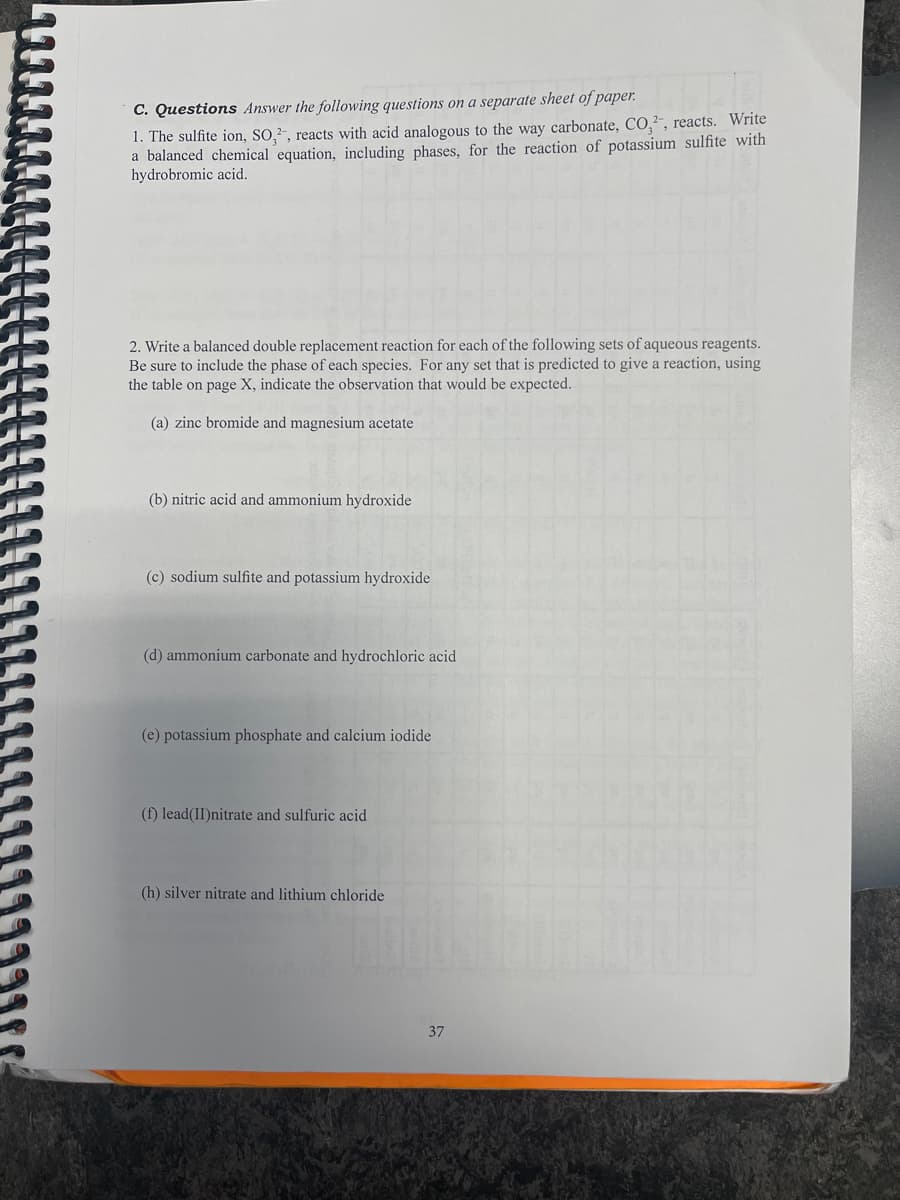2. Write a balanced double replacement reaction for each of the following sets of aqueous reagents. Be sure to include the phase of each species. For any set that is predicted to give a reaction, using the table on page X, indicate the observation that would be expected. (a) zinc bromide and magnesium acetate (b) nitric acid and ammonium hydroxide (c) sodium sulfite and potassium hydroxide (d) ammonium carbonate and hydrochloric acid (e) potassium phosphate and calcium iodide (f) lead(II) nitrate and sulfuric acid (h) silver nitrate and lithium chloride 37
2. Write a balanced double replacement reaction for each of the following sets of aqueous reagents. Be sure to include the phase of each species. For any set that is predicted to give a reaction, using the table on page X, indicate the observation that would be expected. (a) zinc bromide and magnesium acetate (b) nitric acid and ammonium hydroxide (c) sodium sulfite and potassium hydroxide (d) ammonium carbonate and hydrochloric acid (e) potassium phosphate and calcium iodide (f) lead(II) nitrate and sulfuric acid (h) silver nitrate and lithium chloride 37
Chemical Principles in the Laboratory
11th Edition
ISBN:9781305264434
Author:Emil Slowinski, Wayne C. Wolsey, Robert Rossi
Publisher:Emil Slowinski, Wayne C. Wolsey, Robert Rossi
Chapter33: Preparation Of Copper(i) Chloride
Section: Chapter Questions
Problem 2ASA
Related questions
Question

Transcribed Image Text:C. Questions Answer the following questions on a separate sheet of paper.
1. The sulfite ion, SO2, reacts with acid analogous to the way carbonate, CO,2, reacts. Write
a balanced chemical equation, including phases, for the reaction of potassium sulfite with
hydrobromic acid.
2. Write a balanced double replacement reaction for each of the following sets of aqueous reagents.
Be sure to include the phase of each species. For any set that is predicted to give a reaction, using
the table on page X, indicate the observation that would be expected.
(a) zinc bromide and magnesium acetate
(b) nitric acid and ammonium hydroxide
(c) sodium sulfite and potassium hydroxide
(d) ammonium carbonate and hydrochloric acid
(e) potassium phosphate and calcium iodide
(f) lead(II) nitrate and sulfuric acid
(h) silver nitrate and lithium chloride
37
Expert Solution
This question has been solved!
Explore an expertly crafted, step-by-step solution for a thorough understanding of key concepts.
This is a popular solution!
Trending now
This is a popular solution!
Step by step
Solved in 3 steps with 6 images

Knowledge Booster
Learn more about
Need a deep-dive on the concept behind this application? Look no further. Learn more about this topic, chemistry and related others by exploring similar questions and additional content below.Recommended textbooks for you

Chemical Principles in the Laboratory
Chemistry
ISBN:
9781305264434
Author:
Emil Slowinski, Wayne C. Wolsey, Robert Rossi
Publisher:
Brooks Cole

EBK A SMALL SCALE APPROACH TO ORGANIC L
Chemistry
ISBN:
9781305446021
Author:
Lampman
Publisher:
CENGAGE LEARNING - CONSIGNMENT

World of Chemistry, 3rd edition
Chemistry
ISBN:
9781133109655
Author:
Steven S. Zumdahl, Susan L. Zumdahl, Donald J. DeCoste
Publisher:
Brooks / Cole / Cengage Learning

Chemical Principles in the Laboratory
Chemistry
ISBN:
9781305264434
Author:
Emil Slowinski, Wayne C. Wolsey, Robert Rossi
Publisher:
Brooks Cole

EBK A SMALL SCALE APPROACH TO ORGANIC L
Chemistry
ISBN:
9781305446021
Author:
Lampman
Publisher:
CENGAGE LEARNING - CONSIGNMENT

World of Chemistry, 3rd edition
Chemistry
ISBN:
9781133109655
Author:
Steven S. Zumdahl, Susan L. Zumdahl, Donald J. DeCoste
Publisher:
Brooks / Cole / Cengage Learning